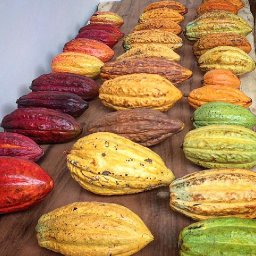Chocolates of Ecuador -- Arriba, Nacional, CCN51
--
~~~~~~~~~~~~~~~~~~~~~~~~~~~~~~~~~~~~~~~~~~~~~~
@DiscoverChoc
updated by @jeff-stern: 09/07/15 11:45:51
--
~~~~~~~~~~~~~~~~~~~~~~~~~~~~~~~~~~~~~~~~~~~~~~
@DiscoverChoc
Sam:
As always, I am struck by the care and thought you've put into your reply.
The story goes (and you are basically right), that traders coming into the port of Guayaquil looking for the famed Ecuadorian "pepe de oro" (golden seed) were told to go "arriba" up the Guayas river to find the beans they were looking for. Today we know these areas as Los Rios, Manabi, Quevedo.
It is also important to note that the bean variety has always been called Nacional. Arriba is the name given to the unique flavor, which is not a genetic characteristic as Sam has noted because rootstock transplanted in other countries does not give rise to beans with the same flavor. So there is something about the terroir - in conjunction with that specific genetics - that results in the flavor. The Nacional flavor is likened to orange blossom with jasmine mixed in. Personally, I think the best example of this flavor I have ever tasted is the first harvest and production of Felchlin's Cru Sauvage.
I also have to agree with Sam about CCN51's undeserved reputation for poor quality. I think the photo she links to was taken on the same trip in 2005 that I was on. In this case, the pods were culled early in the week before being transported to the collection center and there was a national holiday over the weekend and a soccer match against arch-rivals Peru on Monday or somesuch so the beans had been fermenting in bags for at least five days before they were picked over to remove placenta. Unfortunately, the people doing the cleaning were not tasked with removing the rotting beans.
BTW: CCN stands for Collecion Castro Naranjal. Carlos Castro was famous cacao breeder in Ecuador, and the particular hybrid - of a trinitario with the the Nacional - was number 51. It was championed by the Crespo family and it was on their farm outside Guayaquil where we saw beans like this.
Ecuador is famous (or infamous) for its lackadaisical approach to fermentation, probably because of the convoluted market system that evolved out of the destruction of the Hacienda system of the late 1800s, brought about by agrarian land reform. The farmers aren't paid to care (for the most part) so they don't.
While in Ecuador in 2005 we visited a cocoa processor (Tulicorp) where we participated in a chocolate liquor tasting. One of the revelations of the tasting was that one of the best-tasting liquors came from CCN51 beans - that had been properly fermented. Fermented properly, it's possible to make some very decent chocolate using CCN51 beans. Certainly as good as anything made with Amelonado forastero from Western Africa.
--
~~~~~~~~~~~~~~~~~~~~~~~~~~~~~~~~~~~~~~~~~~~~~~
@DiscoverChoc
updated by @casey: 10/10/17 22:04:09
Tags
Activity
Our first podcast episode, Chocolate is Multiple, is live. Please listen and share your feedback!
TheChocolateLife celebrates its 9th anniversary this week, starting publication the week of January 18, 2008. Already planning a 10th Anniversary bash!
Food and Wine Magazine's list of top chocolates in the US.
This appears to have been put together by a committee (there is no byline) and by people who have little or no understanding of the chocolate business. Like most lists produced this way, it's very uneven - mixing very small producers with global mass-market brands, and not differentiation between chocolate makers and confectioners.
What are your thoughts?
This year 2016 was a good year for our small business in Belgium. We now are following some new (for us) small and unique chocolate makers. Such as: Ananda (Ecuador), The Wellington chocolate Factory, Acali, Potamac, Letterpress, PumpStreet Bakery, Dick Taylor and La Naya. We are proud to be the smallest chocolate shop in Belgium following some of the best chocolate makers in the world.
Wishing you all a Merry Christmas and a happy New Year 2016/2017



